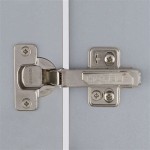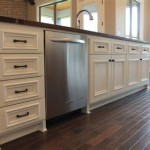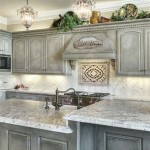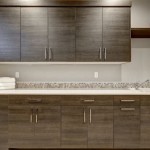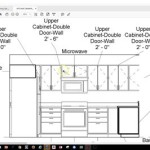What Is A Blind Corner Cabinet Used For In Kitchens?
Blind corner cabinets in kitchens represent a frequent challenge for homeowners. These cabinets, located in the corners where two cabinet runs meet at a 90-degree angle, often feature a significant portion of their storage space obscured and difficult to access. This design arises from the practical need to maximize storage within the spatial constraints of a kitchen layout. The term "blind" refers to the portion of the cabinet that extends back into the corner, making the items stored there hard to see and reach without specialized solutions.
The primary purpose of a blind corner cabinet is to provide storage in an area that would otherwise be wasted. Kitchen designs often prioritize continuous countertops and cabinet runs for aesthetic and functional reasons. Without a specialized cabinet solution, the corner space would either be left empty, leading to a gap and loss of storage, or covered by a less efficient, fixed cabinet system. Blind corner cabinets, therefore, serve as a compromise, utilizing the awkward corner space while presenting entry and access challenges that necessitate specialized hardware and organizational strategies.
The depth and configuration of blind corner cabinets can vary significantly depending on the overall kitchen design and the specific cabinet manufacturer. Some blind corner cabinets may have a relatively shallow "blind" area, while others extend much deeper into the corner, creating a larger but more difficult-to-access storage space. The overall dimensions of the cabinet, including its width, height, and depth, influence the types of storage solutions that can be effectively implemented within it.
The challenge presented by blind corner cabinets has led to the development of various hardware solutions designed to improve accessibility and organization. These solutions range from simple shelving systems to complex pull-out and rotating mechanisms. The choice of solution depends on the budget, the type of items being stored, and the user's preferences regarding functionality and ease of use. Understanding the specific features and limitations of each type of hardware is crucial for maximizing the utility of a blind corner cabinet.
Maximizing Storage with Pull-Out and Swing-Out Systems
One of the most common solutions for addressing the accessibility issues of blind corner cabinets is the use of pull-out or swing-out systems. These systems typically consist of shelves or baskets that are attached to a mechanism that allows them to be pulled out of the cabinet, either partially or fully, providing access to items stored at the back. Swing-out systems often feature shelves that pivot or rotate outwards, bringing the contents of the cabinet into view and within easy reach. These systems are particularly useful for storing pots, pans, and other bulky items that would be difficult to retrieve from the back of a standard blind corner cabinet.
The design of pull-out and swing-out systems varies considerably. Some systems offer individual shelves that operate independently, allowing users to access specific items without disturbing the rest of the contents. Other systems feature interconnected shelves that pull out together, providing a comprehensive view of the entire cabinet interior. The weight capacity of these systems is an important consideration, as they must be able to support the weight of the items being stored without sagging or malfunctioning. High-quality systems are typically constructed from durable materials such as steel or heavy-duty plastic, and they feature smooth, reliable mechanisms that ensure ease of operation.
Installation of pull-out and swing-out systems can be complex, and it is often recommended that they be installed by a professional. Proper installation is essential for ensuring that the system operates smoothly and safely, and that it is properly aligned with the cabinet opening. Inaccurate installation can lead to issues such as binding, squeaking, and premature wear and tear. Furthermore, the installation process may require modifications to the existing cabinet structure, such as drilling holes or reinforcing the cabinet walls. These modifications should be carried out carefully and precisely to avoid damaging the cabinet.
When selecting a pull-out or swing-out system for a blind corner cabinet, it is important to consider the specific dimensions of the cabinet and the type of items that will be stored. Measuring the interior dimensions of the cabinet is crucial for ensuring that the system will fit properly and that it will provide sufficient storage space. It is also important to consider the height and depth of the items that will be stored, as this will influence the spacing and configuration of the shelves or baskets. Choosing a system that is specifically designed for the intended purpose will help to maximize the efficiency and convenience of the blind corner cabinet.
Utilizing Lazy Susans for Easy Access
Another popular solution for improving accessibility in blind corner cabinets is the use of a Lazy Susan. A Lazy Susan is a rotating platform that allows users to easily access items stored at the back of the cabinet by rotating the platform. This eliminates the need to reach deep into the cabinet to retrieve items, making it a convenient solution for storing frequently used items such as spices, condiments, or small appliances. Lazy Susans are available in a variety of sizes and materials, and they can be easily installed in most blind corner cabinets.
There are two primary types of Lazy Susans commonly used in blind corner cabinets: full-circle and pie-cut. Full-circle Lazy Susans are circular platforms that rotate 360 degrees. They are best suited for cabinets with a square or rectangular opening, as they can fully utilize the available space. Pie-cut Lazy Susans, on the other hand, are designed to fit into corner cabinets with a triangular opening. They are shaped like a slice of pie and rotate within the confines of the corner, providing access to the items stored on the platform.
The material of a Lazy Susan can also impact its performance and durability. Common materials include plastic, wood, and metal. Plastic Lazy Susans are typically the most affordable option, but they may not be as durable as those made from wood or metal. Wooden Lazy Susans offer a more aesthetically pleasing appearance and can be stained or painted to match the surrounding cabinetry. Metal Lazy Susans are the most durable option, and they are often coated with a protective finish to prevent rust and corrosion.
Installation of a Lazy Susan is generally a straightforward process. Most Lazy Susans come with detailed instructions and all the necessary hardware for installation. The first step is to measure the interior dimensions of the cabinet to ensure that the Lazy Susan will fit properly. Next, the base of the Lazy Susan is attached to the floor of the cabinet using screws or adhesive. Finally, the rotating platform is placed on the base and secured in place. It is important to ensure that the Lazy Susan is properly aligned and that it rotates smoothly before loading it with items.
Strategic Organization and Storage Techniques
Beyond specialized hardware, strategic organization and storage techniques can significantly improve the usability of a blind corner cabinet. The key is to categorize and store items in a way that maximizes accessibility and minimizes wasted space. Regularly used items should be placed at the front of the cabinet, while less frequently used items can be stored further back. This ensures that the items you need most often are within easy reach.
Utilizing containers and baskets is an effective way to organize items within a blind corner cabinet. Clear plastic containers allow you to easily see the contents without having to remove them from the cabinet. Baskets can be used to group similar items together, such as baking supplies or cleaning products. Labeling the containers and baskets is also helpful for identifying the contents quickly and easily. This is especially important for items stored at the back of the cabinet, which may be difficult to see.
Another useful technique is to create zones within the blind corner cabinet. For example, one zone could be dedicated to storing pots and pans, while another zone could be used for storing small appliances. This makes it easier to find specific items and prevents the cabinet from becoming cluttered and disorganized. Using shelf dividers can also help to create distinct zones and prevent items from sliding around. These dividers can be made from wood, plastic, or metal, and they can be easily installed using screws or adhesive.
Regularly decluttering the blind corner cabinet is essential for maintaining its usability. Over time, items can accumulate that are no longer needed or used. Removing these items frees up valuable storage space and makes it easier to find the items that are actually needed. A good practice is to declutter the cabinet at least once a year, discarding any expired or unwanted items. This will help to keep the cabinet organized and efficient, and it will prevent it from becoming a dumping ground for unwanted items.
Ultimately, the most effective use of a blind corner cabinet involves a combination of appropriate hardware solutions and thoughtful organization strategies. By carefully considering the specific needs and limitations of the space, homeowners can transform a challenging area into a valuable and functional storage resource.

Blind Corner Cabinets Step By Guide On How To Install

Blind Corner Accessories Info

Blind Corner Cabinet Ideas To Maximize Space

How To Deal With The Blind Corner Kitchen Cabinet Live Simply Method

Blind Corner Cabinets Step By Guide On How To Install

How To Deal With The Blind Corner Kitchen Cabinet Live Simply Method

What Is A Blind Corner Cabinet The Homestud

Ultimate Guide To Blind Corner Cabinets

How To Deal With The Blind Corner Kitchen Cabinet Live Simply Method

How To Deal With The Blind Corner Kitchen Cabinet Live Simply Method
Related Posts

